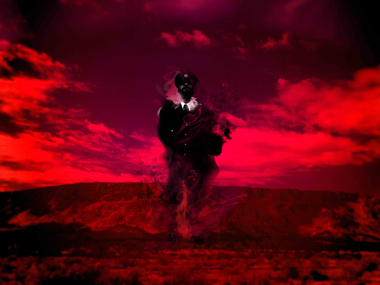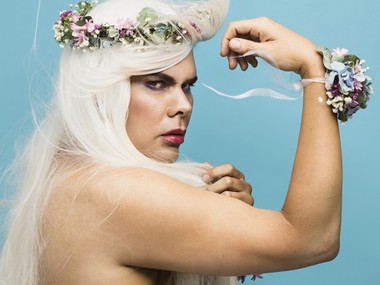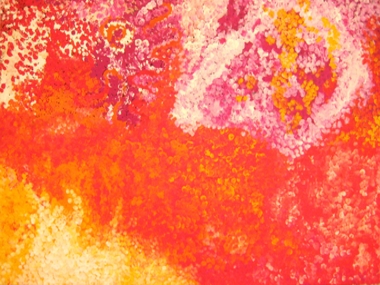ART IS THE VOICE OF OUR PEOPLE - TAKE 2

'Untitled' by Warwick Thornton - himself as a policeman metamorphosing into a Debil Debil.
Posted by Jeremy Eccles | 15.07.14
Hetti Perkins second 'Art+Soul' TV series returns to the ABC tonight, and winds up with a third episode next Tuesday. And the question I asked after previewing her first program remains as relevant to the thinking behind this production as ever: “Is Art+Soul 2, then, a series primarily about Indigenous art – as might be suggested by the National Gallery of Australia's co-production credit - or is it more about the Blak politics that proudly proclaim,”We have survived” in your white world without really wanting to examine the ceremonial basis of tribal life that permitted the survival of a civilisation for 40,000+ years earlier?”
In fact, by the time we'd been through the Black Wars and Bass Strait islands genocide in Tasmania, the Coniston Massacre and the Maralinga atomic tests in Central Australia and political prisoners on Palm Island, the series seemed to be shaping up more akin to Hetti's sister Rachel's 'First Australians' than an art series.
But occasionally the art crept through! What a delight to discover Nicole Foreshaw, an artist whose work must have shone at last year's distressingly under-publicised Corroboree Festival in Sydney (curated by H Perkins). “Cultural pride can overcome prejudices”, Foreshaw insists as her striking images of generations of Aboriginal women clad in material she's moulded in the land through natural dyes and weathering played on the Australian Museum walls.
The urbane and ubiquitous Christian Thompson also delights with his revelations of childhood and family influences that I'd never have guessed at from his narcissistic self-portrayals that are so hard to associate with his anthropological researches in Oxford. While absolutely accepting his project that “My cultural identity becomes part of the international cultural discourse”, it's performative events like the exchange of sweat with his surprisingly military father and their greetings in the Bidjara language that really justify Perkins' filming.
As I've said before, it's so much easier for Perkins to engage with a worldly character like Thompson, the European art-referencing Torres Strait artist, Brian Robinson or the artist/film-maker Warwick Thornton than to delve beneath the surfaces of remote artists like Myra Cook and Frank Young. The wildly dotting Cook at Wanarn in the Ngaanyatjarra Lands and Young, one of the lesser-known Anangu talents at that APY hothouse, Tjala Arts in tiny, remote Amata are given pretty short-shrift, despite the issue of revelation of story being a major issue amongst the Anangu men. Meanwhile, the art of the region wins prize after prize for its vibrancy.
What emerges most clearly from this unbalanced series, then, is the assiduous and valuable research that urban artists like Tasmanian Julie Gough are bringing to their work with the intention of “re-writing the records that were all written by non-Aboriginal people”; offering such a different approach to history to that of Wanyubi Marika and Myra Cook, who have no need to re-write history because they're living in timeless continuity with it.
As Hetti Perkins herself recognises with her Welcome to Country quote which caps off the series: “We are the people of the land – which is our country – always was, always will be”.
Share this:
»  del.icio.us
»
del.icio.us
»  Digg it
»
Digg it
»  reddit
»
reddit
»  Google
»
Google
»  StumbleUpon
»
StumbleUpon
»  Technorati
»
Technorati
»  Facebook
Facebook
Contact Details

Christian Thompson in a recent work of his, 'Ellipse' (2014)

A vibrant work by Myra Cook telling the classic Seven Sisters Dreaming story
Further Research
Artists: Brian Robinson | Christian Thompson | Frank Young | Julie Gough | Myra Cook | Nicole Foreshaw | Wanyubi Marika | Warwick Thornton
News Tags: ABC TV | Art+Soul | Hetti Perkins | Jeremy Eccles | Tasmanian genocide
News Categories: Event | Feature | Industry | Media | News | Other Event
Exhibition Archive
- 10.10.17 | TARNANTHI 2017
- 11.08.17 | Natsiaas 2017
- 20.07.17 | APY ART DOMINATES THE WYNNE
- 17.07.17 | Anangu Artist Wins $100,000 Prize
- 14.07.17 | The End of AAMU
- 11.07.17 | ART ACROSS THE COUNTRY
- 11.07.17 | TARNANTHI IN OCTOBER
- 05.07.17 | TJUNGUṈUTJA - from having come together
- 13.06.17 | Ghost-Nets Straddle the World
- 07.06.17 | Grayson Perry Going Indigenous?
- 05.06.17 | Barks Bigger than Ben Hur
- 27.05.17 | NGA QUINQUENNIAL 2017
- 21.05.17 | Blak Douglas Finds Home at the NGA
- 21.05.17 | BRIAN ROBINSON WINS HAZELHURST WOP
- 18.05.17 | PARRTJIMA 2.0
Advertising

